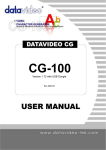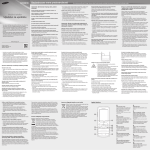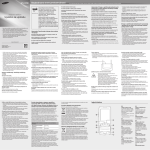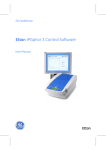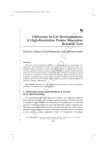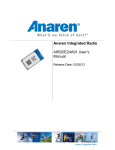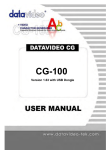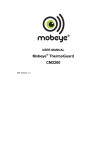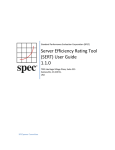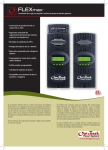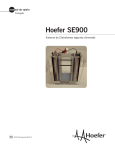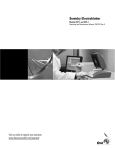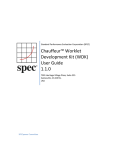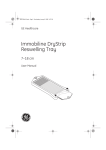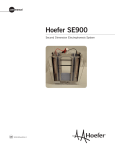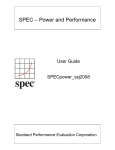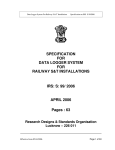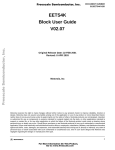Download IEF100 User Manual – English
Transcript
user manual Hoefer IEF100 Isoelectric Focusing Unit um IEF100-IM/Rev.B0/07-12 Page Finder Important Information.................................................................ii Waste Electrical And Electronic Equipment (WEEE)..................... vi Function and Description............................................................1 Specifications............................................................................2 System Components ..................................................................3 Component Descriptions..............................................................5 Programming the IEF100..........................................................10 IEF100 Operation.....................................................................20 Optional Data Connections........................................................35 Care and Maintenance .............................................................42 Technical Service and Repair ...................................................42 Troubleshooting........................................................................43 Ordering Information ...............................................................45 Appendix A: Preprogrammed Protocols.......................................46 Appendix B: Reagents and Solutions..........................................51 Appendix C: References IEF100................................................57 • pi Important Information – English • If this equipment is used in a manner not specified by Hoefer, Inc. the protection provided by the equipment may be impaired. • This instrument is designed for indoor laboratory use only. • Only accessories and parts approved or supplied by Hoefer, Inc. may be used for operating, maintaining, and servicing this product. • Only use a power supply that is CE marked or safety certified by a nationally recognized testing laboratory. • The safety lid must be in place before connecting the power supply leads to a power supply. • Turn all power supply controls off and disconnect the power leads before removing the safety lid. • Circulate only water or 50/50 water/ethylene glycol through the heat exchanger if so equipped. Do not connect the heat exchanger to a water tap or any coolant source where the water pressure is unregulated. • Never introduce antifreeze or any organic solvent into any part of the instrument. Organic solvents will cause irreparable damage to the unit! • Do not operate with buffer temperatures above the maximum specified technical specifications. Overheating will cause irreparable damage to the unit! Duležité Informace – Czech • Pokud by toto zařízení je použito způsobem, který není podle Hoefer, Inc. ochrana poskytovaná na základě zařízení může být narušena. • Tento nástroj je určen pro vnitřní použití v laboratoři pouze. • Pouze příslušenství a části schválen, nebo poskytnutých Hoefer, Inc. mohou být použity pro provoz, údržbu, a údržbě tohoto výrobku. • zdroj napájení používají jen že je opatřen označením CE osvědčena nebo bezpečnost vnitrostátně uznanými zkušebními laboratoř. • Bezpečnosti lid musí být zavedena před připojením napájecí zdroj napájení vede k. • Turn veškeré napájení kontroly vypnuto a odpojit před odběrem energie vede bezpečnostní víko. • Rozeslat pouze voda nebo 50/50 voda/ethylenglykolu prostřednictvím výměník tepla je li to vybavena. Nemají připojení výměník tepla s vodními setřepná nebo jakékoli chladicí kapaliny zdroje, kde tlak vody je neregulo. • Nikdy zavést prostředek proti zamrznutí nebo jakákoli organická rozpouštědla do jakékoli části z tohoto nástroje. Rozpustidlům způsobí nenapravitelné poškození jednotka! • Nejsou provozována s pufru teplotách nad maximální stanovenou technickými specifikacemi. Přehřátí způsobí nenapravitelné poškození jednotka! Vigtig Information – Danish • Hvis dette udstyr bruges i en måde ikke specificeret ved Hoefer, Inc. den beskyttelse, som er blevet forsynet af udstyret kan måske svækkes. • Dette instrument er designet for indendørs laboratoriumbrug bare. • Bare tilbehør og del godkendede eller forsynede ved Hoefer, Inc. kan måske bruges for drive, funktionsfejl, og betjening dette produkt. • pii • bruger Bare en strømforsyning, der er CE markerede eller sikkerhed, som er blevet attesteret af en, som nationalt er blevet anerkendt prøve laboratorium. • Sikkerhedlåget må være på plads før forbinding strømforsyningsblyet til en strømforsyning. • Drejer alle strømforsyningskontroller af og afbryder kraftblyet før fjerning sikkerhedlåget. • Cirkulerer bare vand eller 50/50 vand/ethylene glykol gennem varmeveksleren i så fald udrustet. Forbind ikke varmeveksleren til en vandhane eller nogen kølemiddelkilde hvor vandtrykket er unregulated. • Introducerer Aldrig antifreeze eller noget organisk opløsningsmiddel ind i nogen del af instrumentet. Organiske opløsningsmidler vil forårsage uboelig skade til enheden! • Driver ikke med stødpudetemperaturer over maksimummet specificerede tekniske specifications. Overheding vil forårsage uboelig skade til enheden! Belangrijke Informatie – Dutch • Indien deze uitrusting in een manier wordt gebruikt die niet door Hoefer, Inc. is gespecificeerd de bescherming die door de uitrusting is verzorgd kan worden geschaad. • Dit instrument is voor binnenlaboratoriumgebruik enkel ontworpen. • Enkel onderdelen en delen keurden goed of leverden door Hoefer, Inc. kan voor het bedienen worden gebruikt, handhavend en onderhouden van dit product. • gebruik Enkel een netvoeding die CE is markeerde of veiligheid die door een is gecertificeerd die nationaal is herkend testene laboratorium. • Het veiligheidsdeksel moet in plaats voor het verbinden van de netvoeding leidt tot een netvoeding zijn. • Doe alle netvoedingscontroles Uit en koppel los de machtleiding voor het verwijderen van het veiligheidsdeksel. • Circuleer enkel water of 50/50 water/ethyleenglycol door de hitte exchanger zo ja uitrust. Verbind de hitte exchanger naar een waterkraan of koelmiddelbron niet waar de waterdruk niet geregulariseerd is. • Stel Nooit antivriesmiddel of organische oplosmiddelen in deel van het instrument voor. Organische oplosmiddelen zullen onherstelbare schade aan de eenheid veroorzaken! • Bedien niet met buffertemperaturen boven het maximum specificeerde technische specificaties. Oververhittend zal onherstelbare schade aan de eenheid veroorzaken! Tärkeää Tietoa – Finnish • Jos tätä varusteita käytetään tavassa ei määritetty Hoefer, Inc. suojelu ehkäisty varusteille saattaa olla avuton. • Tämä väline suunnitellaan sisälaboratoriokäytölle vain. • Vain lisävarusteet ja osat hyväksyivät tai toimitti Hoefer, Inc. oheen ää voi käyttää käyttämiselle, valvoalle, ja servicing tämä tuote. • Vain käyttää käyttöjännitettä joka on CE merkitsi tai turvallisuus joka on todistanut aidoksi ohi joka on kansallisesti tunnustettnut testaaminen laboratoriota. • Turvallisuuskansi täytyy olla paikallaan ennen yhdistäminen käyttöjännitelyijyjä käyttöjännitteeseen. • Kiertää kaikki käyttöjännitevalvonnat ja irrottaa valtalyijyt ennen poistaminen turvallisuuskantta. • Kiertää vain vesi tai 50/50 vesi/ethyleneä glycol siinä tapauksessa varustetun lämmönvaihtimen läpi. Älä yhdistä lämmönvaihdinta vesinapautukseen eikä jäähdytysnestelähteeseen, missä vesipaine on unregulated. • Pakkasneste eikä orgaaninen liuotin välineen osassa ei esitele Koskaan. Orgaaniset liuottimet aiheuttavat korvaamattoman vahingon yksikköön! • Ei käytä puskuria yllä olevia lämpötiloja enintään määritetyillä teknisillä täsmennyksillä. Ylikuumeneminen aiheuttaa korvaamattoman vahingon yksikköön! Information Importante – French • Si cet équipement est utilisé dans une manière pas spécifié par Hoefer, Inc. la protection fourni par l’équipement pourrait être diminuée. • Cet instrument est conçu pour l’usage de laboratoire intérieur seulement. • Seulement les accessoires et les parties ont approuvé ou ont fourni par Hoefer, Inc. pourrait être utilisé pour fonctionner, maintenir, et entretenir ce produit. • utilise Seulement une alimentation qui est CET a marqué ou la sécurité certifié par un nationalement reconnu essayant le laboratoire. • Le couvercle de sécurité doit être à sa place avant connecter l’alimentation mene à une alimentation. • Tourner tous contrôles d’alimentation de et débrancher les avances de pouvoir avant enlever le couvercle de sécurité. • Circuler seulement de l’eau ou 50/50 glycol d’eau/éthylène par l’exchanger de chaleur si si équipé. Ne pas connecter l’exchanger de chaleur à un robinet d’eau ou à la source d’agent de refroidissement où la pression d’eau est non régulée. • Ne Jamais introduire d’antigel ou du dissolvant organique dans n’importe quelle partie de l’instrument. Les dissolvants organiques causeront des dommages irréparables à l’unité! • Ne pas fonctionner avec les températures de tampon au-dessus du maximum a spécifié des spécifications techniques. La surchauffe causera des dommages irréparables à l’unité ! Wichtige Informationen – German • Wenn diese Ausrüstung gewissermaßen nicht angegeben durch Hoefer, Inc. verwendet wird, kann der durch die Ausrüstung zur Verfügung gestellte Schutz verschlechtert werden. • Dieses Instrument wird für den Innenlaborgebrauch nur dafür entworfen. • Nur Zusätze und Teile genehmigten oder lieferten durch Hoefer, Inc. kann für das Funktionieren, das Aufrechterhalten, und die Wartung dieses Produktes verwendet werden. • Verwenden Sie nur eine Energieversorgung, die CE gekennzeichnet oder durch ein national anerkanntes Probelaboratorium bescheinigte Sicherheit ist. • Der Sicherheitsdeckel muss im Platz vor dem Anschließen der Energieversorgung sein führt zu einer Energieversorgung. • Alle Energieversorgungssteuerungen abdrehen und die Macht trennen führt vor dem Entfernen des Sicherheitsdeckels. • Nur Wasser oder 50/50 Glykol des Wassers/Äthylens durch den Wärmeaustauscher, wenn so ausgestattet, in Umlauf setzen. Verbinden Sie den Wärmeaustauscher mit einem Wasserklaps oder jeder Kühlmittel-Quelle nicht, wo der Wasserdruck ungeregelt wird. • Führen Sie nie Frostschutzmittel oder jedes organische Lösungsmittel in jeden Teil des Instrumentes ein. Organische Lösungsmittel werden nicht wiedergutzumachenden Schaden der Einheit verursachen! • Mit Puffertemperaturen über angegebenen technischen Spezifizierungen des Maximums nicht funktionieren. Die Überhitzung wird nicht wiedergutzumachenden Schaden der Einheit verursachen! Informazioni Importanti – Italian • Se quest’apparecchiatura è usata in un modo specificato da Hoefer, Inc. la protezione fornito dall’apparecchiatura potrebbe essere indebolita. • Questo strumento è disegnato per l’uso di laboratorio interno solo. • Solo gli accessori e le parti hanno approvato o hanno fornito da Hoefer, Inc. potrebbe essere usato per operare, per mantenere, e per revisionare questo prodotto. • usa Solo un alimentatore che è CE ha marcato o la sicurezza certificato da un nazionalmente riconosciuto testando il laboratorio. • Il coperchio di sicurezza deve essere nel luogo prima di collegare i piombi di alimentatore a un alimentatore. • Spegne tutto i controlli di alimentatore e disinserisce i piombi di potere prima di togliere il coperchio di sicurezza. • Circola solo l’acqua o 50/50 glicole di acqua/etilene attraverso lo scambiatore di calore se così equipaggiato. Non collegare lo scambiatore di calore a un rubinetto di acqua o qualunque fonte di refrigerante dove la pressione di acqua è sregolata. • Non introduce mai l’antigelo o qualunque solvente organico in qualunque parte dello strumento. I solventi organici causeranno il danno irreparabile all’unità! • Non opera con le temperature di tampone al di sopra del massimo ha specificato le descrizioni tecniche. Il surriscaldamento causerà il danno irreparabile all’unità! Viktig Informasjon – Norwegian • Hvis dette utstyret blir brukt i en måte ikke spesifisert ved Hoefer, Inc. beskyttelsen som ha blitt git av utstyret kan bli svekket. • Dette instrumentet er utformet for innendørs laboratoriumbruk bare. • Bare tilbehør og deler godkjente eller forsynte ved Hoefer, Inc. kan bli brukt for drive, vedlikeholde, og betjene dette produktet. • bruker Bare en kraftforsyning som er CE merket eller sikkerhet som ha blitt sertifisert av et som nasjonalt ha blitt anerkjent prøver laboratorium. • Sikkerheten lokket må være på plass før forbinding kraftforsyningene blyene til en kraftforsyning. • Vender all kraftforsyningsstyring av og frakopler kreftene blyene før fjerning sikkerheten lokket. • Sirkulerer bare vann eller 50/50 vann/ethylene glykol gjennom oppvarmingen veksleren i så fall utstyrer. Ikke forbind oppvarmingen veksleren til en vanntapp eller noe kjølemiddelkilde hvor vannet • piii trykket er unregulated. • Introduserer Aldri antifreeze eller noe organisk løsemiddel inn i noe del av instrumentet. Organiske løsemiddler vil forårsake irreparabel skade på enheten ! • Driver med buffertemperaturer over maksimum ikke spesifiserte teknisk spesifikasjoner. Å overoppheting vil forårsake irreparabel skade på enheten ! qualquer parte do instrumento. Orgânico solvente causará agressão irreparável à unidade! • Não opera com temperaturas de buffer acima do máximo especificou especificações técnicas. Superaquecer causará agressão irreparável à unidade! Wazne Informacje – Polish • Si este equipo es utilizado en una manera no especificado por Hoefer, Inc. la protección proporcionado por el equipo puede ser dañada. • Este instrumento es diseñado para el uso interior del laboratorio sólo. • Sólo accesorios y partes aprobaron o suministraron por Hoefer, Inc. puede ser utilizado para operar, para mantener, y para atender a este producto. • Sólo utiliza una alimentación que es CE marcó o la seguridad certificada por un nacionalmente reconocido probando el laboratorio. • La tapa de la seguridad debe estar en el lugar antes de conectar la alimentación lleva a una alimentación. • Apaga todos controles de alimentación y desconecta los plomos del poder antes de quitar la tapa de la seguridad. • Circula sólo agua o 50/50 glicol de agua/etileno por el intercambiador de calor si ése es el caso equiparon. No conecte el intercambiador de calor a un toque de la agua ni cualquier fuente del líquido refrigerante donde la presión del agua está libre. • Nunca introduce anticongelante ni algún solvente orgánico en cualquier parte del instrumento. Los solventes orgánicos causarán daño irreparable a la unidad! • No opera con temperaturas de búfer encima del máximo especificó especificaciones técnicas. Recalentar causará daño irreparable a la unidad! • Jeżeli ten sprzęt jest wykorzystywany w sposób nie określone przez Hoefer, Inc. do ochrony przewidzianej przez urządzenie może zostać obniżony. • Instrument ten jest przeznaczony do użytku w laboratoriach kryty tylko. • Tylko akcesoriów i części zatwierdzone lub dostarczone przez Hoefer, Inc. mogą być wykorzystane do eksploatacji, utrzymania i obsługi tego produktu. • korzystać jedynie zasilacza że jest noszące oznakowanie CE lub bezpieczeństwa uwierzytelnione przez uznane na poziomie krajowym laboratorium badawcze. • Bezpieczeństwo lid musi być w miejsce przed podłączeniem zasilania prowadzi do zasilania. • Zaś wszystkie źródła zasilania urządzenia sterujące off i odłączyć moc prowadzi przed odbiorem bezpieczeństwa lid. • Krążą tylko wody lub wody 50/50/ethylene glycol wymiennik ciepła poprzez jeśli tak wyposażone. Nie należy połączyć wymiennik ciepła woda z kranu lub jakimkolwiek chłodziwo źródła, jeżeli ciśnienie wody jest nieuregulowanych. • Nigdy nie wprowadzać rozpuszczalnika organicznego przeciw zamarzaniu lub jakichkolwiek na dowolną część dokumentu. Rozpuszczalniki organiczne spowoduje nieodwracalne szkody dla jednostki! • Nie działają w buforze temperatury powyżej maksymalnego określone specyfikacje techniczne. Przegrzania spowoduje nieodwracalne szkody dla jednostki! Informações Importantes – Portuguese • Se este equipamento é usado numa maneira não especificada por Hoefer, Inc. que a protecção fornecida pelo equipamento pode ser comprometida. • Este instrumento é projectado para uso de interior de laboratório só. • Só acessórios e partes aprovaram ou forneceu por Hoefer, Inc. pode ser usada para operar, manter, e servicing este produto. • Só usa um estoque de poder que é CE marcou ou segurança registrada por um nacionalmente reconhecido testando laboratório. • A tampa de segurança deve estar em lugar antes de ligar o estoque de poder leva a um estoque de poder. • Desliga todos controlos de estoque de poder e desconecta os chumbos de poder antes de retirar a tampa de segurança. • Circulam só água ou 50/50 glicol de água/ethylene pelo exchanger de calor se for assim equiparam. Não ligue o exchanger de calor a uma torneira de água nem qualquer fonte de refrigerante onde a pressão de água é não regulado. • Nunca introduz anticongelante nem qualquer orgânico solvente em • piv Información Importante – Spanish Viktig Information – Swedish • om denna utrustning används i ett sätt som inte har specificeras av Hoefer, Inc. skyddet tillhandahöll vid utrustningen kan skadas. • Detta instrument formges för inomhuslaboratorium användning bara. • Bara medhjälpare och delar godkände eller levererade vid Hoefer, Inc. kan användas för fungera, underhålla, och servicing denna produkt. • använder bara en kraft tillgång som är CE markerade eller säkerhet intygade vid en nationellt erkänd testande laboratorium. • Säkerheten locket måste vara på platsen före koppla kraften tillgången blyen till en kraft tillgång. • Vänder sig alla kraft tillgång kontroller av och kopplar bort kraften blyen före flytta säkerheten locket. • Cirkulerar bara vatten eller 50/50 vatten/ethylene glycol genom värmen exchanger i så utrustad fall. Inte kopplar värmen exchanger till en vatten kran eller något kylmedel källa där vattnet trycket är unregulated. • Inför aldrig kylvätska eller något organiska lösningsmedel in i någon del av instrumentet. Organiskt lösningsmedel ska orsaka irreparable skada till enheten! • Använd inte med buffert temperaturer över det högsta angivna tekniska specifikationerna. Överhettning skulle orsaka irreparabla skador på enheten! Waste Electrical And Electronic Equipment (WEEE) English This symbol indicates that the waste of electrical and electronic equipment must not be disposed as unsorted municipal waste and must be collected separately. Please contact an authorized representative of the manufacturer for information concerning the decommissioning of your equipment. French Ce symbole indique que les déchets relatifs à l’équipement électrique et électronique ne doivent pas être jetés comme les ordures ménagères non-triées et doivent être collectés séparément. Contactez un représentant agréé du fabricant pour obtenir des informations sur la mise au rebut de votre équipement. German Dieses Symbol kennzeichnet elektrische und elektronische Geräte, die nicht mit dem gewöhnlichen, unsortierten Hausmüll entsorgt werden dürfen, sondern separat behandelt werden müssen. Bitte nehmen Sie Kontakt mit einem autorisierten Beauftragten des Herstellers auf, um Informationen hinsichtlich der Entsorgung Ihres Gerätes zu erhalten. Italian Questo simbolo indica che i rifiuti derivanti da apparecchiature elettriche ed elettroniche non devono essere smaltiti come rifiuti municipali indifferenziati e devono invece essere raccolti separatamente. Per informazioni relative alle modalità di smantellamento delle apparecchiature fuori uso, contattare un rappresentante autorizzato del fabbricante. Spanish Este símbolo indica que el equipo eléctrico y electrónico no debe tirarse con los desechos domésticos y debe tratarse por separado. Contacte con el representante local del fabricante para obtener más información sobre la forma de desechar el equipo. Swedish Denna symbol anger att elektriska och elektroniska utrustningar inte får avyttras som osorterat hushållsavfall och måste samlas in separat. Var god kontakta en auktoriserad tillverkarrepresentant för information angående avyttring av utrustningen. • pv Function and Description Note: Ohm’s law states that the 10 mA of output is available at 1000 V and less. The Hoefer IEF100 Isoelectric Focusing instrument is designed to perform isoelectric focusing of proteins in Immobilized pH Gradient (IPG) strips. It is an integrated system with a built-in Peltier cooled temperature platform, and a 12,000 V, 10 W power supply capable of delivering up to 10 mA. There are 30 fully editable protocols, nine of which are pre-programmed with recommended IEF protocols. One running tray will hold all currently available IPG strips, 3.0 – 3.5 mm wide. The IPG strips are run gel side up, using electrode wicks to help remove impurities that collect at the end of the pH gradients. Samples can be loaded into the IPG strips during rehydration, or with sample cups. The IEF100 is fully tested and certified to all applicable international standards. Features of the IEF100 are: •O ne 6 channel tray that focuses: Up to 6, 7 – 24 cm IPG strips using the single electrode set. Up to 12, 7 cm IPG strips using the dual electrode accessory (included). • Sample loading during rehydration or with sample cup. • Monitors current in each IPG strip. • I ntegrated 12,000 volt DC power supply, with 10 mA capability, the most voltage and current capability available. Fig. 1. The Hoefer IEF100. •A large blue/white LCD display for easy viewing that supports a graphical display of voltage and current. •T he ability to program, edit and store up to 30 protocols, each with 9 steps. • Constant power mode. • A real time clock, settable to local time zones. • Temperature controlled platform. • Ethernet and RS232 ports to report data or load protocols. • p1 Specifications This declaration of conformity is only valid for the instrument when it is: Capacity using Single Electrode set 1– 6 IPG strips 7 to 24 cm long • used in laboratory locations, Capacity using Dual Electrode accessory 2– 12 IPG strips 7 cm long Output Volt Current Power 12,000 V 10 mA 10 W •u sed as delivered from Hoefer, Inc. except for alterations described in the user manual, and • c onnected to other CE-labeled instruments or products recommended or approved by Hoefer, Inc. • p2 Power in100 – 240 V 50 – 60 Hz 100 W User interface Large blue/white graphical display Knob 7 button keypad Platform temperature 15 – 25 °C Protocol capacity 30 programs with 9 steps each Input/output ports Ethernet, RS232 Dimension (w × d × h) 38 cm × 27 cm × 19 cm Weight 8 kg Environmental operating conditions Indoor use Humidity Altitude Installation category Pollution degree Product certifications EN61010-1:2001, EN61326:1998, CE, WEEE, RoHS 4 – 40 °C up to 80% up to 2000 m II 2 System Components Unpacking Unwrap all packages carefully and compare the contents with the packing list, making sure all items arrived. If any part is missing, contact your local Hoefer, Inc. sales office. Inspect all components for damage that may have occurred while the unit was in transit. If any part appears damaged, contact the carrier immediately. Be sure to keep all packing material for damage claims or to use should it become necessary to return the unit. Required but not supplied: • Immobilized pH Gradient (IPG strips). • Reagents required for sample preparation and strip rehydration. • Mineral oil. Fig. 2. The IEF100 unit. • p3 Fig. 3. Instrument components. Electrode Wicks IEF106 Accessory Box Level Forceps Sample Cups IEF108 (–) Electrode Brush Large Rehydration/ Equilibration Tray IEF110 Small Rehydration/ Equilibration Tray IEF109 115 V Power Cord (+) Electrode Focus Tray IEF105 Not pictured: Dual Electrode Accessory IEF212. 230 V Power Cords (EU and UK) • p4 Component Descriptions Safety Lid The transparent safety lid must be closed in order for voltage to be applied to the electrodes. Interlocks are used to stop the voltage output should the lid be opened during electrophoresis. Knob Note: Turn the knob slowly to get desired movement on the screen. Turning the knob too fast causes the cursor to blink, and stay in place. If this happens, turn the knob slower until the proper behavior is observed. Note: The click action of the knob is to quickly push and release, like a mouse click. Do not hold the knob in. The knob moves the cursor or changes the values of a given field. Pressing the knob inwards to “click” switches between these two functions. A LED indicates which function is active, MOVE or SET. Horizontal Arrow Keys The horizontal arrows are used when setting protocol names, and the date and time fields. High Volt Indicator LED This LED is lit when voltage is being applied to the electrodes. Safety lid Fig. 4. Front of the instrument. Knob Horizontal Arrow Keys High Voltage LED STOP Button LCD Display Function Keys RS232 port Ethernet Port • p5 STOP Button Immediately stops the IEF, and terminates the protocol. LCD Display The large blue/white display simplifies the interface, and displays graphical IEF results. Function Keys The function of these keys is shown on the display directly above the key. The function varies depending on what screen is active. Ethernet Port/RS232 Port These two ports can be used to download IEF data from the instrument and transfer protocols. Air Flow Fans pull air in through the side vents, and blow air out the rear vents. The air cools the electronic components, and helps the Peltier modules maintain constant temperature. Mains Power The power entry module operates at all volts and frequencies. Leveling Feet/Bubble Level The leveling feet and the bubble level can be used to level the IEF platform. A level instrument will help ensure oil completely covers the IPG strips. Fig. 5. Rear panel. Leveling Feet Note: The vents should not be blocked. Air Out Vents Air In Vents (2X) • p6 Power Entry Module ON/OFF Switch Focusing Tray The 6 channel focusing tray accommodates IPG strips up to 24 cm in length. Small grooves in the tray allow for easier removal of the IPG strip after focusing. Detail of these features can be seen on page 24. The channels in the tray are numbered 1– 6, from front to back of the IEF100. The tray fits in the instrument in only one orientation. It is set in place on the right side of the platform, and moved sidewise to the left, clamping the tray down against the cold plate. The clamping mechanism improves the heat transfer for the plastic trays. There are (+) and (–) marks on the tray and the instrument to help with proper orientation. Fig. 6. Top of the instrument. (+) Electrode (–) Electrode Focusing Tray Sample Cups Clamps Align IEF Strips with this Line + Front of Instrument Clamping Tabs (6X) – • p7 Electrodes Positive Electrode (Anode) A high volt connector attaches the positive (+) electrode(s) to the high volt terminal. The anode has a single white wire and connector, and locates on the left side of the tray. Negative Electrode (Cathode) A six wire (lan) connector attaches the negative (–) electrode(s) to the ground terminal, monitoring the current in each lane. The cathode locates on the right side of the tray. Electrodes should be placed in the tray with the number “1” towards the front of the tray, and the platinum wire electrodes facing the middle of the IPG strips. Fig. 7. Positive electrode (top), and negative electrode (bottom). (+) Positive Electrode (–) Negative Electrode • p8 Electrode Wicks Note: The electrodes will not make contact with the IPG strips without the electrode wicks in place. The electrode wicks are small rectangular filter papers that are placed over the end of the IPG strips. The electrodes make contact with the top of the wicks. The electrode wicks help remove impurities that collect at the end of the IPG strips, and generally improve electrode contact. The electrode wicks come in long strips, and must be cut apart into individual rectangles as they are used. The electrode wicks need to be moistened by lightly blotting with water prior to use. Sample Cups Note: The sample cups can be cut into individual cups, if desired. The sample cups load protein into the IPG strip. Sample cups can hold up to 240 μl of sample. The cups can be applied in most places along the length of the IPG strip, and are normally applied at the anode (+) end. Fig. 8. Sample cups. Rehydration/Equilibration Trays The rehydration/equilibration trays can be used for both functions. The lanes are narrow enough for proper rehydration, but deep enough to hold the volume of reagent required for equilibration. A small tray is included for use with 7 cm IPG strips. The large tray can be used with IPG strips up to 24 cm in length. Fig. 9. Rehydration/equilibration trays. Brush The cleaning brush is used for cleaning the focusing tray. Forceps Forceps facilitate handling of IPG strips. • p9 Programming the IEF100 Main Screen When turned ON, the main screen is displayed (Fig. 10). The main screen contains the following fields. Date and Time The date and time are set up at Pacific Standard Time. Use the OPTION button to set the date and time for your location. (See options screen page 17). List of 30 Protocols The first nine protocols are shown on the display. One of the protocols is always highlighted. Use the knob to scroll through the other protocols. The instrument is preloaded with 9 protocols for focusing 7, 18 or 24 cm IPG’s. These are general guidelines for focusing. IPG strip manufacturers normally give recommended focusing times in total volt-hours (volts multiplied by hours). Both under and over focusing can be problematic. Optimum focusing times should be determined by the end user considering the IPG strip, the sample type and sample protein load. All protocols can be overwritten, if desired. In addition to these 9 protocols, there are 21 additional unnamed protocols without preprogrammed steps, allowing the user ample space to create custom protocols. Fig. 10. Main screen. • p10 The Four Buttons: EDIT, RUN, OPTION and GRAPH EDIT Edits the highlighted protocol. RUN Starts the highlighted protocol. OPTION Allows access to port settings and the date and time. GRAPH Note: The last run data is retained in memory until a new run is started. Once a new run is started, the last run data is no longer available. Will display the volt and measured currents graphically. Use the knob to scroll through the voltage and the µA profiles in channels 1– 6. The active run will be displayed. If not actively running a protocol, the graph button will display the last run data. Note: The volt and current graphs can not be printed directly from the IEF100. If data output is sent to a computer, the data can be transferred to a program such as Excel to create the graph. • p11 Edit Protocol Screen From the main menu, use the knob to highlight the desired protocol. Press the button beneath EDIT on the screen. The IEF100 will now display the edit protocol screen (Fig. 11). All IEF parameters are displayed on one screen. Each protocol can be programmed with up to nine steps. The protocol ends with the first step that has a step time of zero. Fig. 11. Edit protocol screen. All parameters for an entire protocol are viewable on one screen. Use the knob to move between the following editable fields. Once highlighted, click the knob to change the value of the field. Protocol Number Click the knob. The knob will now cycle through the 30 protocols, allowing a quick review of each protocol. Protocol Name Protocol names can have up to 16 alphanumeric symbols. The following symbols are available: ABCDEFGHIJKLMNOPQRSTUVWXYZ %.@/-+mun 0123456789 Highlight the protocol name field, and click the knob. A cursor will cause the first character to blink. Turn the knob to scroll through the above symbols. Once the desired symbol is reached, use the horizontal arrows (the keys directly beneath the knob) to move the cursor to the next position. Repeat until the protocol name is correct. The “blank space” is between the lower case “n” and the “0” symbols. • p12 The lower case “m”, “u”, and “n” can be used to designate milli, micro, and nano, if desired. When the name is correct, click the knob to enter the name, and move to the next field. Delay The delay line is an optional step. Both a time and a temperature can be entered. Focusing will start after the delay time has elapsed. This can be helpful for overnight runs where the user may want to have focusing end at some specific time the next morning. The Peltier modules will maintain the cold plate at the set temperature. Note: Times to the nearest minute increment can be uploaded to protocols from a computer. Parameter Units Range Increment Time (hour:min) 0:00 – 99:59 0:15 Temperature (°C) 15 – 25 1 IEF Limits Note: It is recommended not to exceed 6000 V or more than 0.5 W/ strip for a 7 cm IPG. Please follow the IPG strip manufacturer’s instructions for recommended limits. Maximum volt, current per strip, and watt per strip are applied to the protocol. These settings will override the values in the individual steps. These overall limits can be used to avoid certain focusing conditions that cause damage or problems with the IPG strips. The temperature for the focusing is also set. Since the isoelectric points of proteins are temperature dependent, IEF is typically at a single temperature, usually 20 °C. It is not recommended to use temperatures lower than 20 °C as it can cause problems with urea crystallization in the IPG strip. Parameter Units Range Volt Knob Settable Increments Computer Settable Increments (V) 0 – 12,000 250 1 Current/strip (μA) 0 – 999 25 1 Watts/strip (W) 0 – 2.0 0.1 0.1 Temperature (°C) 15 – 25 1 1 • p13 Steps To edit any step parameter, turn the knob to highlight the parameter. Press the knob, and turn the knob to set the desired value. Press the knob again to enter the value, and move to the next field. Each step has four fields that can be edited: the step type, a step value, a step time, and step units: Step Type Constant volt, gradient volt, constant watt. Step ValueSets the maximum value of volt or watt depending on step type. Step Time Time in hours or volt-hours. Step Units Hours (Hrs) or volt-hours (Vhrs). Step Type and Step Value Note: It is not recommended to set a series of discrete volt steps. The discontinuities between steps cause spikes in power levels that tend to increase the chances of burning strips. Each step can be programmed in one of three different modes, constant volt, gradient volt, or constant watt. Note: In some cases, the volt settings may never be reached. • I n gradient volt, the voltage will start at the end voltage of the previous step and increase (or decrease) linearly over time to the voltage entered in the current step. If the first step of the protocol is a gradient volt step, the voltage will increase from 0. Note: If a constant watt step is followed by a gradient volt step, the gradient volt step will start from 0, and increase linearly to the set voltage. • I n constant volt, the voltage remains constant thoughout the length of the step. •G radient volt steps gradually increase the power being applied to the IPG strips, resulting in more even heating of the strip over time. •C onstant watt steps will smooth out the heat generation as much as possible over the course of the IEF separation. There will still be localized heating due to different ion concentrations along the length of the IPG strips. •W hen using the constant watt step, the units for the step value automatically change to watts. • I n constant watt steps, the IEF100 calculates the resistance, and adjusts the voltage to maintain the constant watt setting. • p14 Step Time Note: When switching between time units, the IEF100 will convert between hours and Vhrs automatically. It may help to set the step time units (Hrs or Vhrs) before the numerical endpoint is entered. Steps can be programmed to run for a set amount of time, Hrs (00:00 in hours:minutes), or for a set amount of volt-hours, Vhrs (volts multiplied by the number of hours). Most IEF strip manufacturers recommend to run the IPG strips to a specific volt-hours endpoint. The researcher should determine the endpoint for their specific sample. The first step with a 0 value entered in the step time is treated as the end of the protocol. Step Value Step Type Range Knob Settable Increments Computer Settable Increments Constant Volt 0 – 12,000 250 1 Gradient Volt 0 – 12,000 250 1 Constant Watt 0.1 – 2.0 0.1 0.1 Step Time Hrs (hours:minutes) 00:00 – 99:59 0:15 0:01 Vhrs (volt-hours) 0 – 300,000 500 1 • p15 Run Screen Note: The IEF100 instrument monitors the current and wattage in each individual strip. If necessary, conditions can be adjusted and/or problematic strips can be removed. The information on the run screen is described in detail in the IEF operation section. The run screen has no editable fields. It does have the following four soft keys, MAIN, PAUSE, NEXT and GRAPH (Fig. 12). Fig. 12. Run screen. Note: The IEF100 also beeps between step changes. MAIN Allows the user to review and edit all protocols while the current IEF is still running. PAUSE The PAUSE button interrupts the high voltage to the IPG strips, allowing the user to interface safely with the strips. After a pause, RUN will continue from where it was interrupted, or ABORT will terminate the run. NEXT The NEXT button allows the user to skip the remaining portion of the active step, and start the next step in the protocol. GRAPH The GRAPH button will display the current run results graphically. Use the knob to scroll through the voltage profile, and the µA profiles in channels 1– 6. Press EXIT to return to the run screen. At the end of the run the IEF100 will beep, and turn off the high voltage power supply. A screen displays the protocol number, the end date and time, and the final IEF conditions in each IPG strip. • p16 Options Screen Note: When the options screen is accessed, the IEF100 will first check to see if there is an ethernet connection. The IEF100 is inaccessible until the check is completed (about 10 seconds). The words “Checking Ethernet” will flash until the check is completed. From the main menu, pressing the OPTION key will allow access to the following options (Fig. 13). Serial Port and Intvl Ethernet Date/Time Diagnostics Clear all protocols Serial Number Fig. 13. Options screen. Serial Port The serial port sets the speed at which data is sent to or received from an external device. The baud rate can be set to 9600, 38400 or 57600, with 38400 being the default. The baud rate should match the data reporting rate of the external device (computer or printer serial port). Intvl The time interval between data points sent to an external receiving device. The IEF100 internally records data points every minute. When downloading the data, the interval between data points can be changed from 1 to 15 minutes. The default interval is 5 minutes. For long runs, it may be desirable to have fewer data points, and therefore use higher values for the interval. Ethernet The ethernet connection is determined automatically. “NO CONNECTION” will be displayed until an ethernet cable is attached to the port. Once an active LAN connection is established, the local server will assign an IP address that will be displayed in the XXX. XXX.XXX.XXX format. This process usually takes about 10 seconds. • p17 To Set the Date The date field is three separate fields of DAY/MONTH/YEAR. 1Use the knob to highlight the date field. Click the knob to set the date. 2Turn the knob to change the date. Use the horizontal arrows (the keys directly beneath the knob) to access the MONTH and YEAR fields, if necessary. 3When all three fields are correct, press the knob to enter the new date. To Set the Time The time field is two separate fields, HOUR:MINUTE. The HOUR field uses the range 0 – 24 to denote the time of day. 1Use the knob to highlight the time field. Click the knob to set the time. 2Turn the knob to change the HOUR. Use the horizontal arrows (the keys directly beneath the knob) to access the MINUTE field, if necessary. 3When both fields are correct, click the knob to enter the new time. Diagnostics 1Highlight diagnostics, and click the knob. The function key RUN appears on the screen. Press RUN to show a popup screen with three options: Run Diags Manual Vout Cancel 2 Use the knob to select the option, and press the function OK. Run Diags The diagnostics function has the IEF100 go through a series of internal tests to confirm function. The tests include the voltage and current output of the internal high voltage power supply, the eprom, and the clock. If everything tests OK, the message “All OK” is briefly displayed on the screen. If one of the tests fail, contact the Hoefer, Inc. representative to arrange service for the instrument. Manual Vout Press OK to show a run screen. Click the knob to SET mode, and the voltage output is adjustable in 250 V increments. The manual run will continue until stopped by the user, or up to 4 hours. • p18 Exiting this screen will return to the main menu. Clear All Protocols Note: You cannot recover user programmed protocols once they have been reset, or erased. This option is used to overwrite the existing protocols in memory. A popup screen shows three options: Defaults Erase Cancel • Highlight the appropriate option and press OK. •D EFAULTS resets all 30 protocols to the factory default settings, i.e., the nine pre-programmed protocols and 21 empty protocols. •E RASE deletes all the data in all 30 protocols in memory. Empty protocols have default limits of 12,000 V, 500 μA/strip, 2 W/strip and 20 °C. Serial Number Displays the serial number of the IEF100. This is not editable. • p19 IEF100 Operation Note: Push the knob inwards, and release quickly to “click”. There is tactile and audible feedback. A successful click changes between MOVE and SET modes. Using the Knob The knob has two actions, it turns, and pushes in to “click” (Fig. 14). Turn: Navigates through fields, adjusts values. Click: Changes between MOVE and SET modes, as indicated by the LED. 1In MOVE mode, highlight the field that you want to change. 2Click the knob to change to SET mode. 3Turning the knob will now adjust the value of the field. When the proper value is shown, click the knob again to enter the value, and change back to MOVE mode. Turning the knob will now move to the next field. IEF100 Setup Fig. 14. The knob. 1Plug the IEF100 into a grounded mains outlet using the appropriate power cord. An adapter may be necessary in some countries. The power entry module is on the rear panel. The ON/OFF switch is located on the power entry module (Fig. 15). 2Allow for clearance around instrument and enough clearance above to allow for opening the lid. The vents should not be blocked. Do not allow fluids to enter the side intakes. 3Wash the electrode tray, rinse well with deionized water and allow to air dry. 4Gently clean electrode platinum wire contact points and allow to air dry. 5When the unit is inactive for a period of time a screensaver will be displayed to prolong the life of the display. Push any button to exit the screensaver. Fig. 15. ON/OFF switch. Printer and Computer Connections Attach and configure a printer or a computer before focusing, and the IEF100 automatically sends output data in real time (Fig. 16). See Optional Data Connections, page 35. Fig. 16. Ethernet connection. • p20 Preparing IPG Strips Immobilized pH Gels (IPG) are ultra thin polyacrylamide gels on plastic support films. The gels are made with a pH gradient covalently bonded into the gel matrix. The gels are stable and reproducible. The gels are supplied dehydrated and should be stored at temperatures -20 °C or below. The IPG strips have an acidic (+) end and a basic (–) end. 2D gel images are typically shown with the acidic side on the left, and that is the orientation of the IPG strips in the IEF100. The proper electrode must be applied to each end: anodic (+) electrode to the acidic end (left) and the cathodic (–) electrode to the basic end (right). The dried strips require rehydration before the run. Typically, several different reagents are included in the rehydration solution to help solubilize the proteins, and enable successful isoelectric focusing. Rehydration is typically done at room temperature, or 20 °C, and needs a minimum of 8 hours for good absorption of the reswelling solution. It is frequently more convenient to allow rehydration to occur overnight. During rehydration, the IPG strips are covered in mineral oil to prevent loss of moisture, and prevent urea crystallization. The IPG strips are rehydrated using one of the rehydration/equilibration trays supplied with the IEF100. Protein sample can be added to the IPG strip in this step. The IPG strips are transferred to the IEF100 for focusing. • p21 Rehydration of IPG Strips Note: The IEF100 is a convenient place to rehydrate strips. The cold plate will maintain a constant temperature, and the cover will help protect the IPG strips from dust. A brief discussion of rehydration ingredients and their function is included in Appendix B, along with some recommended solutions. The reagents can be customized for specific samples. The volume of solution is dependent on the length of the strip to be used. Hoefer recommends following the IPG strip manufacturer’s recommendations. A table of typical volumes is included below. Strip Length (cm) Note: Using more than the recommended volumes may contribute to loss of protein or blurry IEF results. Note: Rehydration solutions typically contain high concentrations of urea that tend to crystallize at lower temperatures. For this reason, rehydration should not be done in cold rooms or in environments significantly colder than 20 °C. Note: Sliding the strips in the rehydration buffer will wet the entire length of the strip, and helps prevent sticking. Strips placed directly against the plastic bottom of the rehydration tray may stick, and not rehydrate properly. • p22 Volume per Strip (μl) 7 130 18 340 24 450 Apply rehydration solution in a channel of the appropriately sized rehydration tray in a line slightly shorter in length than the strip to be rehydrated. Many IPG strip manufacturer’s cover the strips with a protective cover. If present, peel off protective layer. Place the strip, gel side down, onto the liquid in the channel. Gently slide the strip back and forth to wet the entire length of the IPG gel with rehydration solution. Sometimes, lifting and lowering the IPG strip can aid in getting the proper contact of the solution over the entire length of the IPG gel strip. Cover the strips with mineral oil, Hoefer order number GR138-1. Allow to rehydrate a minimum of 8 hours. Better rehydration occurs if allowing strips to rehydrate overnight. Isoelectric Focusing (using the Single Electrode Set) 1 Open the safety lid by pressing down on the white push label in the middle of the front of the lid (Fig. 17). 2 Fig. 17. Open the safety lid. Insert the IEF105 focusing tray on the far right side of the cold plate. The tray has only one orientation. There are (+) and (–) marks on the tray that align with corresponding marks on the IEF100. The tray will not fit properly in the IEF100 in any other orientation. 3 Slide the focusing tray to the left under the clamping tabs (Fig. 18). These tabs improve the contact, and the heat transfer, between the tray and the cold plate. 4 Fig. 18. Slide the focusing tray. Use forceps to load the rehydrated IPG strips into the focusing tray gel side up. The anodic (+) end of the strips should be on the left, matching the (+) on the tray and the IEF100 (Fig. 19). The strip channels are numbered so that channel 1 is closest to the front and channel 6 is at the back of the IEF100. Fig. 19. Load the IPG strips. Note: In any one run, all the IPG strips should be the same length for the electrodes to make good contact. • p23 5 Align the (+) end of the strips with the alignment mark in the tray (Fig. 20). This will help in two ways. First, the clamping tabs will not interfere with the positioning of the electrodes. Secondly, there are small grooves in the bottom of the channels for forceps to remove IPG strips after IEF. 6 Apply electrode wicks on top of each end of the IPG strips, overlapping the gel by 2– 3 mm, and extending off the end of the IPG strip. •T he electrode wicks are supplied in long perforated strips. Use scissors to cut off the desired number of wicks. Fig. 20. Align strips. • Moisten the IEF wicks with water and gently blot off any excess water. Note: The electrode wicks absorb ions collecting at the ends of the IPG strips, and generally improve the IEF results. Grooves for Forceps to Remove IPG Strips Fig. 21. Focusing tray enlarged. IPG Strip Alignment Line Fig. 22. Wick placement. Clamping Tabs IPG strip alignment features. Do not use sample cup over these features. Platinum Wire IPG Strip Electrode Wick • p24 7 Note: The electrodes will not make contact with the IPG strips without the electrode wick in place. Connect the (+) electrode to the (+) terminal (Fig. 23). 8 Place the (+) electrode on top of the electrode wicks so that the platinum wire is centered in the area of overlap between the wicks and the IPG strip (Fig. 24). The electrode should lightly lock into place. Fig. 23. Connect (+) electrode. Fig. 24. Lock (+) electrode in place. • p25 9 Connect the (–) electrode to the (–) terminal (Fig. 25). 0 Place the (–) electrode on top of the electrode wicks so that the platinum wire is centered in the area of overlap between the wicks and the IPG strip (Fig. 26). The electrode should lightly lock into place. ! Fig. 25. Connect (–) electrode. Fig. 26. Lock (–) electrode in place. Fig. 27. Cover with mineral oil. • p26 Cover the strips and any empty channels with 60 ml mineral oil. Using less oil will risk that IPG strips will not be completely covered and may dry out during the run (Fig. 27). Isoelectric Focusing (using the Dual Electrode Accessory) The Dual Electrode Accessory increases the Hoefer IEF100 capacity, enabling up to twelve, 7 cm IPG strips to be run simultaneously. This is accomplished by running up to six pairs IPG strips in parallel. Each of the six channels will report the sum of the current and wattage of the paired strips, therefore, the current and wattage limits should be set at twice the usual value used when running single strips and, as always, the IPG strips being run simultaneously must be of the same pH and conductivity. 1 Open the safety lid by pressing down on the push label in the middle of the front of the lid. 2 Insert the IEF105 focusing tray on the far right side of the cold plate. The tray has only one orientation. There are (+) and (–) marks on the tray that align with the corresponding marks on the IEF100. The tray will not fit properly in the IEF100 in any other orientation. Fig. 28. IEF100 set up using the Dual Electrode Accessory. 3 Slide the focusing tray to the left under the clamping tabs. These tabs improve the contact, and the heat transfer, between the tray and the cold plate. 4 Use forceps to load the rehydrated 7 cm IPG strips into the focusing tray with the gel side of the strips facing up. 5 The first set of IPG strips should be loaded on the left side of the tray with the anodic (+) end of the strips on the left matching the (+) on the tray and the IEF100. • p27 6 The second set of IPG strips are loaded to the right of the first set in the opposite orientation — with the anodic end (+) of the strips matching the (–) on the tray and the IEF100. The cathodic end (–) of the each set of strips should be facing each other in the center of the focusing tray, approximately 4 cm apart (Fig. 29). 7 Parallel IPG strips should be aligned as closely as possible using the (+) or (–) imprinted on the strip to guide alignment. 8 Apply electrode wicks on top of each end of the IPG strips, overlapping the gel by 2–3 mm, and extending off the end of the IPG strip. •T he electrode wicks are supplied in long perforated strips. Use scissors to cut off the desired number of wicks. • Moisten the IEF wicks with water and gently blot off any excess water. 9 Connect the anode electrodes (+) to the positive (+) terminal on the left side of the IEF100. 0 The anode electrodes are placed on either end of the focusing tray — the left side of the first set of IPG strips and the right side of the second set of IPG strips. The electrodes should be centered on top of the area where the wick overlaps the gel of the IPG strip. ! Connect the cathode electrodes (–) to the negative (–) terminal on the right side of the IEF100. @ The cathode electrodes are placed in the center of the focusing tray — on the right side of the first set of IPG strips and the left side of the second set of IPG strips. The electrodes should be centered on top of the area where the wick overlaps the gel of the IPG strip. Fig. 29. IPG Strip Placement. • p28 Sample Cups Note: There are small semicircular features in the bottom of the tray channels that help align the IPG strip in the middle of the lane. The legs of the sample cup must not hit these features or else the sample cup will leak. See Fig. 21 on page 24. Sample cups can be used to apply protein sample to IPG strips if it was not included in the rehydration buffer. The sample cups are supplied in strips of six cups. The sample cups can be used all together, or cut apart and used separately. 1 ress the sample cups down on top of the IPG strips. The sample cups P should stop on the bottom of the channel and seal on the IPG strips (Fig. 30). In general, most cup loading is done on the anodic end of the IPG strip. Each sample is different. In some situations, samples may focus better loaded elsewhere on a strip. This can only be determined experimentally for different sample types. 2 Up to 240 µl sample can be applied to the sample cups (Fig. 31). 3 Once loaded, confirm the protocol settings. Fig. 30. Place sample cups. 4 Close the lid (Fig. 32). Fig. 31. Apply sample. Fig. 32. Close safety lid. • p29 Start IEF 1 Highlight the desired protocol, and press RUN. 2 Note: The protocol’s overall limits of current/strip and watt/strip will not operate correctly without entering the proper number of channels containing strips. Note: The IEF100 monitors the current and watt in each channel. If necessary, conditions can be adjusted and/or problematic strips can be removed from the run. onfirm the number of focusing tray channels containing IPG strips. Use the C knob to change the value. 3 Press RUN again to start the IEF. 4 he IEF100 will beep to indicate the start of a run. The high voltage T LED will light, and “RUNNING” will be flashing in the top right corner of the display. The run screen will display the current run conditions. • p30 Run Screen The run screen displays all the information on the current run (Fig. 33). There are no editable fields. The information on the run screen is described below. Note: The IEF100 can only control the conditions of one focusing tray channel at a time. The IEF100 limits the channel with the highest current, or watts. IPG strips prepared under identical conditions will show variations due to geometrical differences in the IPG gel and contact differences under the electrodes. IPG strips with different samples can show large differences in current and wattage due to different conductivities of the samples. Line 1 The protocol number and name are shown. The top right corner indicates the run status as either running (flashing), paused or finished. Line 2 Displays the number of IPG strips being focused (or number of channels if using the Dual Electrode Accessory). Line 3 Describes the active step; the step number, the step value (volt or watt/strip) and the step end point (Hrs or Vhrs). Line 4 Displays the total elapsed time and the total volt-hours of focusing up to the moment. Line 5 Displays the total elapsed time and total volt-hours of the active step. Line 6 Displays the real time output conditions of all the strips, including the current volts, the total current, the total watts and the platform temperature. Line 8 –13 Display the individual strip current and watts. Fig. 33. Run screen. • p31 In the example below 6 IPG strips are being focused according to protocol 7, a maximum of 0.5 W/strip and 100,000 volt-hour endpoint (Fig. 34). The protocol is in the third step. The protocol has been running for 4 hours and 24 minutes, or 19,108 volt-hours. Currently, the protocol is 1 hour and 2 minutes and 12,088 volt-hours, into step 3. The internal power supply is delivering 11,574 volts, a total of 156 μA and 1.8 watts across six IPG strips. During a run different strips may control the overall voltage as the resistance of the strips changes during the run. Fig. 34. Run screen. • p32 Typical Isoelectric Focusing Note: Extra salt in the sample tends to flatten the graphs (horizontally) and take longer for the sample to focus. Note: If there are problems with burning IPG strips, set the current limit to 50 µA/strip to ensure safe focusing conditions for the entire separation. Note: The volt and µA are scaled and graphed automatically. The first step is typically set to low voltage to limit the current and let the ions move to the end of the IPG strips without excessive currents. If loading sample with a sample cup, an additional slow step may be added to allow the sample to enter the IPG strip under gentle conditions. In the middle steps, the voltage ramps upwards to a plateau, and this is where most of the focusing occurs. The current decreases down to a minimum value. The graphs below show typical volt and µA profiles (Fig. 35). A final step has been added to the pre-programmed protocols to hold the volt at 1000 V for an hour. This will keep the bands focused in the IEF100 until the next step. Extend the length of this step as necessary. Fig. 35. Typical volts and µA profiles. • p33 Fig. 36. End run screen. When focusing is complete, the IEF100 will beep, and an end run screen will be displayed (Fig. 36). Line 1 The protocol number and name. The word finished is displayed in the upper right corner. Line 2 The number of strips run (or number of channels if using the Dual Electrode Accessory). Line 3 The date and time that focusing terminated. Line 4 The total time and volt-hours of focusing. Line 5 The last step time and volt-hours. Line 6 The volts, and the total current and watts of all IPG strips at the end of the run. Line 8–13 The conditions in each strip at the end of the run. Note: Whenever a new IEF is started, the previous IEF data is permanently lost. Note: Do not equilibrate the IPG strips before storing at -20 °C. • p34 The results can be viewed graphically by pushing the function GRAPH. The data will be retained in memory until a new run is started. At this point, the IPG strips can be stored at -20 °C. Or, if the second dimension is to proceed immediately, the buffer needs to be exchanged in a two step equilibration process before second dimension PAGE. Optional Data Connections Serial Printer Connection Use the RS232 port to connect directly to a serial printer. The printer and cable are not supplied. The serial printer should have the following settings. Baud Rate9600, 38400 or 57600 (must match IEF100 baud rate setting) Data Bits 8 Parity None Stop Bit 1 Flow Control None The following section describes the serial computer connection or a ethernet connection to the IEF100. HyperTerminal Connection HyperTerminal is a Windows™ program that can communicate with external devices. By setting up a connection between a computer and the IEF100, the user can: • Import and export protocols from the IEF100. • Capture data output from the IEF100. • Control the IEF100. The description and screens below are HyperTerminal screens. Other terminal emulator programs will also work using the same settings. Configuring the Communications Port 1 Start HyperTerminal in Windows. 2 Click Windows “Start” command. 3 Launch All Programs-Accessories-Communications-HyperTerminal. 4 Assign a name to the new connection (Fig. 37). Fig. 37. Assign name to the new connection. • p35 Serial Port Configuration 1Select a Com Port (Fig. 38). This is the computer port to communicate directly with the IEF100. Choose TCP/IP if connecting via the ethernet connection. Fig. 38. Select a Com Port. 2Set the baud rate to the same as the IEF100, 9600, 38400 or 57600 and 8 data bits, no parity, 1 stop bit, hardware flow control (Fig. 39). Fig. 39. Set the baud rate. • p36 TCP/IP Connection Using the Ethernet Port Use the IEF100 ethernet port to connect to a local area network (LAN). Plug a live ethernet cable into the port. The LAN will automatically assign an internet address to the IEF100. The internet address is shown on the IEF100 options screen. Ethernet Port Configuration 1From the HyperTerminal properties screen, select the TCP/IP (Winsock) option at the communication port properties windows (Fig. 40). 2Press OPTION from the main screen of the IEF100. The local server should automatically assign an internet address in the XXX.XXX.XXX.XXX format. Enter the IP address to the IEF100 in the host address line in XXX.XXX.XXX.XXX format (Fig. 41). 3 Set the port number to 10001 (Fig. 41). Fig. 40. Select the TCP/IP option. Fig. 41. Enter IP address and port number. • p37 4 Click on the “SETTINGS” tab and the “ASCII Setup” button (Fig. 42). 5 In the ASCII setup section, check the boxes “Send line ends with line feeds” “Echo typed characters locally” (Fig. 43). 6 Set the line delay to 30 milliseconds. 7 Set the character delay to 0 milliseconds 8 In the ASCII receiving section, check the box “Wrap lines that exceed terminal width” Fig. 42. Fig. 43. • p38 Capturing IEF100 Data Note: The data from the IEF100 is a series of text fields separated by commas. One method to transfer data to other programs is to use the Windows clipboard to copy and paste the data. 1Make sure a good connection exists between HyperTerminal and the IEF100. 2Open HyperTerminal. Type “AT” and press ENTER. “OK” should appear in the HyperTerminal window. 3There are two ways to download data from the IEF100. The data can be collected in real time, or sent as a data log file after focusing. Collect in Real Time 1With HyperTerminal program open, use the HyperTerminal menus to access Transfer/Capture text (Fig. 44). 2Name the file and directory that will collect the data. Use the browse button, if necessary (Fig. 45). The data from the IEF100 is sent automatically to the output ports every 5 minutes. Once a run is started, data will automatically start appearing in the HyperTerminal window. Fig. 44. 3After focusing, to stop the data capture, use the menus Transfer/ Capture Text/Stop or Pause (Fig. 46). 4 The data is stored in the named file. Transfer Data Log After IEF 1 Fig. 45. Type “XDATALOG” in an active HyperTerminal window. 2The data from the last run will be transferred to the HyperTerminal window. Fig. 46. Note: Copying and pasting the data will, by default, put all the data into one column in an Excel spreadsheet. Use the Excel menu Data/Text to columns command, set the delimiter as commas, and the data will sort into columns for graphing. • p39 HyperTerminal Commands The HyperTerminal program communicates with the IEF100 by transmitting one line of data at a time. Multiple lines can be typed and sent together. Type each line perfectly the first time, and press enter, for the command to be successfully loaded into the IEF100. All commands are case sensitive. Correcting typographical errors in a line of data using the backspace and delete keys will not result in successful communication. The first command to type in HyperTerminal should be “AT” and enter. A good connection is verified with the word OK returning in the HyperTerminal window. Examples of protocols are given at the end of Appendix A. These can be cut and pasted to help with the line formatting. A subset of useful HyperTerminal commands are given on the following page. • p40 Subset of HyperTerminal Commands Command Command Description Expand Description Result of Command Format of Command AT Check connection Check to see if the connection “OK” comes back between HyperTerminal and the with a good connection. IEF100 is good and configured properly. AT XDATALOG Transfer data Transfer data from the IEF100 memory to HyperTerminal. XDATALOG Output Data Format Line 1 Header Line 2 datapoints End Line prot#,protname,startdate,starttime,#datapoints minute,volt,µAC1,µAC2,µAC3,µAC4,µAC5,µAC6,temp END,enddate,endtime Where µAC1 is the current in microamps in channel 1. IPROT Import protocol Import and overwrites one of the 30 protocol slots: transfers protocol from computer to IEF100. Data log shows up in HyperTerminal. Uploads protocol into IEF100 memory. 2 line formats depending on step type Input Data format Delay step – IPROT,prot#,protname,step#,delaytime,delaytemp,runtemp,maxµA,maxA,maxVolt,maxWatt IPROT,5,18cm const Watt,D,0:00,20,20,500,12000,1.5 Step – IPROT,prot#,protname,step#,steptype,stepvalue,timeunits,timeunits,time IPROT,5,18cm const Watt,2,W,1.5,V,25000 EPROT,# Export protocol Copies protocol number # from IEF100 to HyperTerminal. Protocol appears in HyperTerminal window. EPROT,# (# is 1–30) EPROT, Export all protocols Copies all 30 protocols from IEF100 to HyperTerminal. Protocol appears in HyperTerminal window. EPROT, PrnRate,# Data interval setting Changes interval between data points (1–15 minutes). INTVL in IEF100 will update. PrnRate,# (# is 1–15) Start,#1,#2 Start protocol Starts protocol #1 with #2 IPG strips. IEF100 will start focusing.Start,#1,#2 (#1 is 1–30) (#2 is 1–6) Start Resumes protocol Restarts a protocol in a paused state. IEF100 will resume focusing. Stop Stop protocol Stops a protocol in progress. IEF100 will terminate focusing. Stop Pause Pause protocol Pauses a protocol in progress. IEF100 will pause focusing. Pause Report Sends current status. Sends current run data, if actively focusing, sends current run data, if paused, sends a paused message, if not running, prints “idle”. Report ID? Sends serial number. ID? Transfers IEF100 serial number to the computer. Start • p41 Care and Maintenance Turn the mains power switch off and unplug the power cord before cleaning. Instrument and Lid •U se a soft cloth dampened with water or a mild cleaning solution to clean the cabinet and display. • I f spilled liquids contact the circuit boards, unplug the IEF100 and allow to dry completely. Call Hoefer, Inc. for advice before using. Cleaning the Tray and Electrodes •A detergent designed to remove oil is recommended, followed by mild, nonionic laboratory cleaning reagents. Rinse tray well with deionized water and dry completely before use. •T he platinum wire on the electrodes is fragile and should be cleaned very gently. The electrodes should not be soaked in solution. Technical Service and Repair Hoefer, Inc. offers complete technical support for all of our products. If you have any questions about how to use this product, or would like to arrange to repair it, please call or fax your local Hoefer, Inc. representative. • p42 Troubleshooting Problem Solution Instrument does not turn onCheck power cord is plugged into grounded outlet and ON/OFF switch is turned to the on (l) position. Lid is openUnit will not operate unless the safety lid is fully closed. Press down on both sides to engage latches. Unit reads 0 μA, 0 W for all stripsEnsure the electrode wicks are in contact with the IPG strips. The electrodes should be contacting the electrode wicks, and centered in the area of overlap between the wick and the IPG strips. Check that the IPG strips have been fully hydrated prior to use. Ensure the electrodes are connected to the corresponding receptacles. Low starting voltage of gradient steps may not produce enough current to register at the beginning of the step. Check the current in the strips again in a few minutes. Run diagnostics to check the internal power supply. Unit reads 0 μA, 0 W for only one stripPoor IPG strip rehydration: inspect the thickness (height) of the IPG strip over its entire length. Check for arcing or burning that could break the electrical circuit. Broken wire in the (–) electrode. Replace electrode. No voltage output Run diagnostics from the options menu. Contact your local Hoefer, Inc. representative. Blank display Turn unit off and on. Contact your local Hoefer, Inc. representative. Screen frozen Turn unit off and on. Contact your local Hoefer, Inc. representative. Fails diagnosticsThe diagnostics program will check the volt and current output of the internal power supply, the eprom and the system clock. Contact your local Hoefer, Inc. representative if any of these tests come up negative. • p43 Problem Solution Set voltage not reached Continue with the IEF. IPG strip is being limited by μA or W. Conductivity of the strip is too high. One IPG strip will focus at its max μA or W, and limit the voltage to all strips. This strip can be removed, and the remaining strips will focus at higher voltages. 7 cm strips should not be focused at volts higher than 6000 V and watts higher than 0.5 W per strip. Browning, burning of strips arcing, erratic μA readings Strips have high conductivity due to salts or other ionic compounds. Reduce the ionic strength by limiting salt concentration to 10 mM or below. Reduce Tris concentrations to 50 mM or below. This indicates the power, volt or current delivered to the strip is too high. Limit current in the IPG strips to 50 μA. Too little oil and/or strips not completely covered in oil. Level the instrument. Ensure mineral oil completely covers the strips, and the empty channels. If strips are not completely covered urea will crystallize out and cause local heating/burning. Overheating of the tray. Check tray is securely slid and locked into place to ensure the best contact between the tray base and the platform surface. Rehydration/equilibration tray has residual liquid after rehydration of IPG strips Excess volume used. Do not exceed the IPG strip manufacturer’s recommended volumes. Strip accidentally rehydrated with the gel side up or strip cover sheet not removed. Extend rehydration time. 8 –10 hours minimum is required for the best uptake of rehydration solution. No proteins present in gel after 2nd dimension completed Load of proteins is too little for the detection method. Load more protein or try a more sensitive method of detection. IPG strip was not properly hydrated. • p44 Ordering Information Product Quantity Order Code IEF100 1 IEF100 Running Tray 1 IEF105 504 IEF106 Electrode Wicks Sample Loading Cups (10 strips of 6) 60 IEF108 Small Rehydration/Equilibration Tray 1 IEF109 Medium Rehydration/Equilibration Tray 1 IEF111 Large Rehydration/Equilibration Tray 1 IEF110 Power Cord US, 115 V 1 PSCORD-115V Power Cord Euro, 230 V 1 PSCORD-230V Second Dimension Units Mighty Small II Deluxe Mini Vertical Unit SE260-10A-1.5 Deluxe Dual Cooled Standard Vertical Unit SE600X-15-1.5 Large Format Vertical Unit SE900-1.0 Reagents Agarose 500 g GR140-500 Bromophenol Blue, Sodium Salt 10 g GR120-10 CHAPS 10 g GR121-10 Dithiothreitol (DTT) 5 g GR122-5 Glycerol 1 L GR124-1 Mineral Oil 1 L GR138-1 Sodium Dodecyl Sulfate 500 g GR126-500 Thiourea 500 g GR130-500 Tris 1 kg GR132-1 Urea 1 kg GR143-1 • p45 Appendix A: Preprogrammed Protocols The following 9 protocols are preprogrammed. They are to be used as guidelines. Each protocol has a 1 hour, 1000 V hold step to maintain sharp bands once focusing is complete. This step is not necessary and can be removed. It can also be extended as desired. Program 1 Focusing of most 7 cm IPG’s by limiting volt parameters. Name: 7 cm broad&basic Delay 0:00, Delay temp 20 °C, Run temp 20 °C, 500 μA, 6000 V, 0.5 W Step 1, Gradient volt, 500 V, 0:30 Hrs Step 2, Gradient volt, 1000 V, 0:30 Hrs Step 3, Gradient volt, 6000 V, 0:30 Hrs Step 4, Constant volt, 6000 V, 8000 Vhrs Step 5, Constant volt, 1000 V, 1:00 Hrs Program 2 Focusing of 7 cm IPG’S under constant watt conditions. Name: 7 cm const watt Delay 0:00, Delay temp 20° C, Run temp 20 °C, 500 μA, 6000 V, 0.5 W Step 1, Constant watt 0.1 W, 1:00 Hrs Step 2, Constant watt 0.5 W, 8000 Vhrs Step 3, Constant volt, 1000 V, 1:00 Hrs Program 3 Focusing of broad and medium 18 cm IPG’s by limiting volt parameters. Name: 18 cm broad&basic Delay 0:00, Delay temp 20°C, Run temp 20°C, 500μA, 12000V, 1.5W Step 1, Gradient volt, 1000V, 1:00 Hrs Step 2, Gradient volt, 12000V, 1:00 Hrs Step 3, Constant volt, 12000V, 25000Vhrs Step 4, Constant volt, 1000V, 1:00 Hrs Program 4 Focusing of 18 cm narrow pH range IPG’s by limiting volt parameters. Name: 18cm narrow Delay 0:00, Delay temp 20 °C, Run temp 20 °C, 500 μA, 12000 V, 1.5 W Step 1, Gradient volt, 1000 V, 1:00 Hrs Step 2, Gradient volt, 12000 V, 1:00 Hrs Step 3, Constant volt, 12000 V, 50000 Vhrs Step 4, Constant volt, 1000 V, 1:00 Hrs • p46 Program 5 Focusing of 18 cm IPG’S under constant watt conditions. Name: 18 cm const watt Delay 0:00, Delay temp 20 °C, Run temp 20 °C, 500 μA, 12000 V, 1.5 W Step 1, Constant watt 0.1 W, 1:00 Hhrs Step 2, Constant watt 1.5 W, 25000 Vhrs Step 3, Constant volt, 1000 V, 1:00 Hrs Program 6 Focusing of broad and medium range 24 cm IPG’s by limiting volt parameters. Name: 24 cm broad&basic Delay 0:00, Delay temp 20 °C, Run temp 20 °C, 500 μA, 12000 V, 2.0 W Step 1, Gradient volt, 1000 V, 1:00 Hrs Step 2, Gradient volt, 12000 V, 1:00 Hrs Step 3, Constant volt, 12000 V, 45000 Vhrs Step 4, Constant volt, 1000 V, 1:00 Hrs Program 7 Focusing of 24 cm narrow pH range IPG’s by limiting volt parameters. Name: 24 cm narrow Delay 0:00, Delay temp 20 °C, Run temp 20 °C, 500 μA, 12000 V, 2.0 W Step 1, Gradient volt, 1000 V, 1:00 Hrs Step 2, Gradient volt, 12000 V, 1:00 Hrs Step 3, Constant volt, 12000 V, 100000 Vhrs Step 4, Constant volt, 1000 V, 1:00 Hrs Program 8 Focusing of 24 cm IPG’S under constant watt conditions. Name: 24 cm const watt Delay 0:00, Delay temp 20 °C, Run temp 20 °C, 500 μA, 12000 V, 2.0 W Step 1, Constant watt, 0.1 W, 1:00 Hrs Step 2, Constant watt, 2.0 W, 45000 Vhrs Step 3, Constant volt, 1000 V, 1:00 Hrs Program 9 Slow, focusing of 24 cm IPG’S with sample loaded into a cup. Gently increases volt over time. Sample entry phase is prolonged and designed to be an overnight run. Name: 24 cm cup load Delay 0:00, Delay temp 20 °C, Run temp 20 °C, 500 μA, 12000 V, 2.0 W Step 1, Gradient volt, 1000 V, 4:00 Hrs Step 2, Gradient volt, 12000 V, 6:00 Hrs Step 3, Constant watt, 2.0 W, 64000 Vhrs Step 4, Constant volt, 1000 V, 10:00 Hrs • p47 Pre-programmed Protocols in Machine Code Format Protocol 1 IPROT,1,7cm IPROT,1,7cm IPROT,1,7cm IPROT,1,7cm IPROT,1,7cm IPROT,1,7cm IPROT,1,7cm IPROT,1,7cm IPROT,1,7cm IPROT,1,7cm broad&basic,D,0:00,20,20,500,6000,0.5 broad&basic,1,G,500,H,0:30 broad&basic,2,G,1000,H,0:30 broad&basic,3,G,6000,H,0:30 broad&basic,4,S,6000,V,8000 broad&basic,5,S,1000,H,1:00 broad&basic,6,S,0,H,0:00 broad&basic,7,S,0,H,0:00 broad&basic,8,S,0,H,0:00 broad&basic,9,S,0,H,0:00 Protocol 2 IPROT,2,7cm IPROT,2,7cm IPROT,2,7cm IPROT,2,7cm IPROT,2,7cm IPROT,2,7cm IPROT,2,7cm IPROT,2,7cm IPROT,2,7cm IPROT,2,7cm const const const const const const const const const const Watt,D,0:00,20,20,500,6000,0.5 Watt,1,W,0.1,H,1:00 Watt,2,W,0.5,V,8000 Watt,3,S,1000,H,1:00 Watt,4,S,0,H,0:00 Watt,5,S,0,H,0:00 Watt,6,S,0,H,0:00 Watt,7,S,0,H,0:00 Watt,8,S,0,H,0:00 Watt,9,S,0,H,0:00 Protocol 3 IPROT,3,18cm IPROT,3,18cm IPROT,3,18cm IPROT,3,18cm IPROT,3,18cm IPROT,3,18cm IPROT,3,18cm IPROT,3,18cm IPROT,3,18cm IPROT,3,18cm • p48 broad&basic,D,0:00,20,20,500,12000,1.5 broad&basic,1,G,1000,H,1:00 broad&basic,2,G,12000,H,1:00 broad&basic,3,S,12000,V,25000 broad&basic,4,S,1000,H,1:00 broad&basic,5,S,0,H,0:00 broad&basic,6,S,0,H,0:00 broad&basic,7,S,0,H,0:00 broad&basic,8,S,0,H,0:00 broad&basic,9,S,0,H,0:00 Protocol 4 IPROT,4,18cm IPROT,4,18cm IPROT,4,18cm IPROT,4,18cm IPROT,4,18cm IPROT,4,18cm IPROT,4,18cm IPROT,4,18cm IPROT,4,18cm IPROT,4,18cm narrow,D,0:00,20,20,500,12000,1.5 narrow,1,G,1000,H,1:00 narrow,2,G,12000,H,1:00 narrow,3,S,12000,V,50000 narrow,4,S,1000,H,1:00 narrow,5,S,0,H,0:00 narrow,6,S,0,H,0:00 narrow,7,S,0,H,0:00 narrow,8,S,0,H,0:00 narrow,9,S,0,H,0:00 Protocol 5 IPROT,5,18cm IPROT,5,18cm IPROT,5,18cm IPROT,5,18cm IPROT,5,18cm IPROT,5,18cm IPROT,5,18cm IPROT,5,18cm IPROT,5,18cm IPROT,5,18cm const const const const const const const const const const Watt,D,0:00,20,20,500,12000,1.5 Watt,1,W,0.1,H,1:00 Watt,2,W,1.5,V,25000 Watt,3,S,1000,H,1:00 Watt,4,S,0,H,0:00 Watt,5,S,0,H,0:00 Watt,6,S,0,H,0:00 Watt,7,S,0,H,0:00 Watt,8,S,0,H,0:00 Watt,9,S,0,H,0:00 Protocol 6 IPROT,6,24cm IPROT,6,24cm IPROT,6,24cm IPROT,6,24cm IPROT,6,24cm IPROT,6,24cm IPROT,6,24cm IPROT,6,24cm IPROT,6,24cm IPROT,6,24cm broad&basic,D,0:00,20,20,500,12000,2.0 broad&basic,1,G,1000,H,1:00 broad&basic,2,G,12000,H,1:00 broad&basic,3,S,12000,V,45000 broad&basic,4,S,1000,H,1:00 broad&basic,5,S,0,H,0:00 broad&basic,6,S,0,H,0:00 broad&basic,7,S,0,H,0:00 broad&basic,8,S,0,H,0:00 broad&basic,9,S,0,H,0:00 • p49 Protocol 7 IPROT,7,24cm IPROT,7,24cm IPROT,7,24cm IPROT,7,24cm IPROT,7,24cm IPROT,7,24cm IPROT,7,24cm IPROT,7,24cm IPROT,7,24cm IPROT,7,24cm narrow,D,0:00,20,20,500,12000,2.0 narrow,1,G,1000,H,1:00 narrow,2,G,12000,H,1:00 narrow,3,S,12000,V,100000 narrow,4,S,1000,H,1:00 narrow,5,S,0,H,0:00 narrow,6,S,0,H,0:00 narrow,7,S,0,H,0:00 narrow,8,S,0,H,0:00 narrow,9,S,0,H,0:00 Protocol 8 IPROT,8,24cm IPROT,8,24cm IPROT,8,24cm IPROT,8,24cm IPROT,8,24cm IPROT,8,24cm IPROT,8,24cm IPROT,8,24cm IPROT,8,24cm IPROT,8,24cm const const const const const const const const const const Watt,D,0:00,20,20,500,12000,2.0 Watt,1,W,0.1,H,1:00 Watt,2,W,2.0,V,45000 Watt,3,S,1000,H,1:00 Watt,4,S,0,H,0:00 Watt,5,S,0,H,0:00 Watt,6,S,0,H,0:00 Watt,7,S,0,H,0:00 Watt,8,S,0,H,0:00 Watt,9,S,0,H,0:00 Protocol 9 IPROT,9,24cm IPROT,9,24cm IPROT,9,24cm IPROT,9,24cm IPROT,9,24cm IPROT,9,24cm IPROT,9,24cm IPROT,9,24cm IPROT,9,24cm IPROT,9,24cm • p50 cup cup cup cup cup cup cup cup cup cup load,D,0:00,20,20,500,12000,2.0 load,1,G,1000,H,4:00 load,2,G,12000,H,6:00 load,3,W,2.0,V,64000 load,4,S,1000,H,10:00 load,5,S,0,H,0:00 load,6,S,0,H,0:00 load,7,S,0,H,0:00 load,8,S,0,H,0:00 load,9,S,0,H,0:00 Appendix B: Reagents and Solutions Sample Preparation Common classes of additives Denaturants Unfold the proteins to expose the internal native charges. Non Ionic Detergents Make samples more soluble without altering the protein charge. Reductants Help break internal disulfide bonds to further unfold the proteins, and help reduce the negative effects of oxidation of proteins during rehydration and IEF. Other Carrier amphoytes, proteases, DNases, RNases. Samples prepared for 2D should be fully denatured, free of insoluble material, and low in overall ionic strength. Some protein samples will readily solubilize while others are more difficult, requiring additional reagents (such as thiourea, special detergents, etc.) to encourage solubilization. The common classes of additives are listed below. Denaturants Urea is the most common reagent used in IEF for disrupting the internal bonding of the protein, allowing it to unfold. Samples are prepared using urea concentrations from 8 – 9.5 M. In general, the higher the urea concentration the better a sample can be solubilized. Urea reaches its saturation point near 10 M at room temperature. Thiourea is also used to better solubilize some samples. Frequently, 2 M thiourea is combined with 5 – 7 M urea as a reagent for sample prep and IPG rehydration. Detergents Several types of non-ionic or zwitterionic detergents can be used to solubilize samples (CHAPS, Triton X100, Nonidet NP-40, and alkylamidosulfobetaine detergents). CHAPS is the most widely used detergent for 2D electrophoresis. It is stable in solution. Detergents such as SDS are not compatible with IEF because they bind to the proteins and mask the proteins’ native charge. Reductants Dithiothreitol (DTT) is commonly used to reduce proteins in IEF. DTT breaks down in solution, so it is normally prepared and added just before use. Other reductants such as 2-Mercaptoethanol, Dithioerythritol (DTE) and Tributylphosphine (TBP) can be used. Other Carrier ampholytes or IPG buffers can be added to aid in protein solubility and help prevent protein precipitation during focusing. Concentrations of 0.5% – 2% (v/v) are typically used. Carrier ampholytes may interfere with certain labeling experiments. In those cases, the reagents should then be omitted from the sample extraction step. • p51 General Guidelines • S ample preparation procedures are being refined and standardized. It is best to consult the literature to determine if a particular sample preparation buffer is recommended for the sample type. • I EF works best with pure protein samples that are solubilized and denatured, and free of interfering molecules. • Remove insoluble material with centrifugation. • Keep the salt content as low as possible. •U se freshly prepared reagents of high quality, or reagent solutions that have been stored frozen. •D o not leave urea solutions out at room temperature for extended periods of time. Note: Salts are perhaps the most common contaminant causing poor IEF results. •N ever heat protein samples in urea solutions. Heating cause carbamylation of proteins and will alter the native charge of the proteins. • Keep samples on ice to prevent degradation. •A dd protease inhibitors to prevent protease activity. Protease inhibitors such as PMSF or Pefabloc can be added to inhibit serine protease activity while pepstatin can inhibit aspartic proteases. • S ome protocols use basic carrier ampholytes or Tris to get a high pH in the sample buffer. This helps solubilize some proteins and lowers enzyme activity that would attack the proteins. •D NA and RNA can frequently be removed by ultracentrifugation. The sample can also be treated with DNase and RNase solution to break down the contaminants. •K eep in mind that some protease inhibitors, DNase and RNase are proteins themselves and may show up on a 2D map. •T he water used for making reagents should be the highest quality available. Water with a resistivity of >5 megaohm-cm is best. Water purified by reverse osmosis or deionized water is acceptable. • p52 Recipes IEF Sample Extraction Buffer for 2D 1A. Urea Sample Buffer Solution Prepares 25 ml 9.5 M urea, 4% CHAPS Final Concentration Amount Urea (FW 60.06) 9.5 M CHAPS 4% (w/v) Deionized water 14.26 g 1.0 g to 25 ml Store in 1 ml aliquots at -20 °C or below. Prior to use, add 6 mg/ml DTT to get a final sample buffer composition of 40 mM DTT. Optional: Add carrier ampholytes, such as SERVALYTS, to a concentration of 2% v/v (20 µl per ml sample buffer solution). — OR — 1B. Thiourea + Urea Sample Preparation Solution Prepares 25 ml 7 M urea, 2 M thiourea, 4% CHAPS, 40 mM DTT Final Concentration Amount Urea (FW 60.06) 7 M 10.51 g Thiourea (FW 76.12) 2 M 3.8 g CHAPS 4% (w/v) 1.0 g Deionized water to 25 ml Store in 1 ml aliquots at -20 °C or below. Prior to use, add 6 mg/ml DTT to get a final sample buffer composition of 40 mM DTT. Optional: Add carrier ampholytes, such as SERVALYTS, to a concentration of 2% v/v (20 µl per ml sample buffer solution). • p53 IPG Strip Rehydration Solution 2A. Urea Rehydration Stock Solution Prepares 50 ml 8 M urea, 2% CHAPS, 0.002% bromophenol blue Final Concentration Amount Urea (FW 60.06) 8 M CHAPS 2% (w/v) 1.0 g Bromophenol blue 0.002% 1 mg Deionized water — 24 g to 50 ml Store in 3 ml aliquots at -20 °C or below. 3 ml is sufficient to rehydrate six 24 cm IPG strips. Just prior to use for IPG strip rehydration: • Add 0.5 – 2.0% (v/v) carrier ampholytes (SERVALYTS). • Add 9 mg DTT per 3 ml aliquot of rehydration stock solution 20 mM DTT. • Protein sample can also be added to the 3 ml of rehydration solution. 2B. Thiourea Rehydration Stock Solution Prepares 50 ml 7 M urea, 2 M thiourea, 2% CHAPS, 0.002% bromophenol blue Final Concentration Amount Urea (FW 60.06) 7 M Thiourea (FW 76.12) 2M 7.6 g CHAPS 2% (w/v) 1.0 g Bromophenol blue 0.002% 1 mg Deionized water — 21 g to 50 ml Store in 3 ml aliquots at -20 °C or below. 3 ml is sufficient to rehydrate six 24 cm IPG strips. Just prior to use for IPG strip rehydration: • Add 0.5 – 2.0% (v/v) carrier ampholytes (SERVALYTS). • Add 9 mg DTT per 3 ml aliquot of rehydration stock solution 20 mM DTT. • Protein sample can also be added to the 3 ml of rehydration solution. • p54 3. SDS Equilibration Buffer Solution This solution is used after IEF, and before second dimension PAGE. The IPG strips are immersed in excess solution to raise the pH of the strip buffer so that it is suitable for PAGE, and to coat the proteins in SDS uniformly so that they migrate properly in the second dimension gel. Note: IPG strips should be equilibrated just prior to second dimensin PAGE. Do not equilibrate the IPG strips before storing at -20 °C. Prepares 200 ml 6 M urea, 75 mM Tris-HCl pH 8.8, 29.3% glycerol, 2% SDS, 0.002% bromophenol blue Final Concentration Urea (FW 60.06) 6 M Amount 72.1 g 1.5M Tris-HCl, pH 8.8 stock solution 75 mM 10.0 ml Glycerol (87% w/w) 29.3% (v/v) 69 ml SDS (FW 288.38) 2% (w/v) 4.0 g Bromophenol blue 0.002% (w/v) 4 mg Deionized water to 200 ml Aliquot into 30 ml aliquots and store frozen at -20 °C or below. 24 cm IPG’s require 5 –10 ml per strip per equilibration step. Shorter strips can use proportionately less volume per equilibration step. Equilibration Procedure 1 Thaw two aliquots of the equilibration solution. 2 Add 10 mg/ml DTT to one solution. 3 Place the IPG strips in the rehydration/equilibration tray. 4 Add 6.5 ml of solution to each slot containing an IPG strip. 5 Place on rocker for 10 –15 minutes. After equilibration, discard the first equilibration solution in an appropriate manner. 6Add 25 mg/ml Iodoacetamide (IAA) to the second aliquot of equilibration solution. 7 Add 6.5 ml of solution to each slot containing an IPG strip. 8 Place on rocker for 10 –15 minutes. After equilibration, discard the second equilibration solution in an appropriate manner. Following equilibration, the IPG strips are placed on the top of the second dimension gel, and sealed into place with the agarose overlay. • p55 Agarose Overlay 1% Agarose in 1X Electrophoresis Buffer Prepares 100 ml 1% agarose, 25 mM Tris, 192 mM glycine, 0.1% SDS Prepare in a 500 ml flask to allow room for foaming. Caution! SDS may cause the solution to boil over so exercise caution when heating and prevent boiling over. Final Concentration Amount Agarose 1% 1g 10X Electrophoresis Buffer (250 mM Tris, 1.92M Glycine, 1% SDS) 1X 10 ml Bromophenol blue 3 mg Deionized water to 100 ml Gently swirl to suspend agarose. Heat at low power in a microwave oven until agarose is fully dissolved. Store in 1.5 ml aliquots at 4 °C in plastic screw top tubes. Reheat aliquots in heating block. • p56 Appendix C: References IEF100 Ames, G. F. L. and Nikaido, K. Two-dimensional gel electrophoresis of membrane proteins. Biochemistry 15, 616–623 (1976). Bjellqvist, B., Ek, K., Righetti, P.G., Gianazza, E., Gorg, A., Westermeier, R. and Postel, W., Isoelectric focusing in immobilized pH gradients: principle, methodology and some applications, J Biochem Biophys Methods 6, 317–339 (1982). Bjellqvist, B., Pasquali, C., Ravier, F. Sanchez, J.C. and Hochstrasser, D. A nonlinear wide-range immobilized pH gradient for two-dimensional electrophoresis and its definition in a relevant pH scale. Electrophoresis 14, 1357–1365 (1993). Dunn, M. J. and Corbett, J. M. 2-dimensional polyacrylamide gel electrophoresis. Methods Enzymol. 271, 177–203 (1996). Eckerskorn, C., Jungblut, P., Mewes, W., Klose, J. and Lottspeich, F. Identification of mouse brain proteins after two-dimensional electrophoresis and electroblotting by microsequence analysis and amino acid composition analysis, Electrophoresis 9, 830–838 (1988). Görg, A., Postel, W., Günther, S. The current state of two-dimensional electrophoresis with immobilized pH gradients. Electrophoresis 9, 531–546 (1988). Görg, A., Postel, W., Weser, J., Günther, S, Strahler, J.R., Hanash, S. and Somerlot, L. Elimination of point streaking on silver stained two-dimensional gels by addition of iodoacetamide to the equilibration buffer. Electrophoresis 8, 122–124 (1987). Görg, A. Two-dimensional electrophoresis, Nature 349, 545–546 (1991). Görg, A. Obermaier, C., Boguth, G., Harder, A., Scheibe, B., Wildgruber, R. and Weiss, W. The current state of two-dimensional electrophoresis with immobilized pH gradients, Electrophoresis 21, 1037–1053 (2000). Görg, A., Obermaier, C., Boguth, G. and Weiss, W. Recent developments in two-dimensional gel electrophoresis with immobilized pH gradients: wide pH gradients up to pH 12, longer separation distances and simplified procedures, Electrophoresis 20, 712–717 (1999). Görg A, Postel W, Domscheit A and Günther S, Methodology of two-dimensional electrophoresis with immobilized pH gradients for the analysis of cell lysates and tissue proteins, in Endler AT and Hanash S (eds) Two-Dimensional Electrophoresis. Proceedings of the International Two-Dimensional. Electrophoresis Conference, Vienna, Nov. 1988, VCH, Weinheim FRG (1989). • p57 Görg, A., Obermaier, C., Boguth, G., Posch, A. and Weiss, W. Two-dimensional polyacrylamide gel electrophoresis with immobilized pH gradients in the first dimension (IPG-Dalt): the state of the art and the controversy of vertical vs horizontal systems. Electrophoresis 16, 1079–1086 (1995). Görg, A., Obermaier, C., Boguth, G., Csordas, A., Diaz, J.J., Madjar, J.J. Very alkaline immobilized pH gradients for two dimensional electrophoresis of ribosomal and nuclear proteins. Electrophoresis 18, 328–337 (1997). Link, A.J. (ed) 2-D Proteome Analysis Protocols, Methods in Molecular Biology 112 Humana Press (1998). O’Farrell, P. H. High resolution two-dimensional electrophoresis of proteins. J. Biol. Chem. 250, 4007–4021 (1975). Olsson, I., Larsson, K., Palmgren, R. and Bjellqvist, B. Organic disulfides as a means to generate streak-free two-dimensional maps with narrow range basic immobilized pH gradient strips as first dimension. Proteomics 2, 1630–1632 (2002). Rabilloud, T., Use of thiourea to increase the solubility of membrane proteins in two-dimensional electrophoresis. Electrophoresis 19, 758–760 (1998). Rabilloud, T., Solubilization of proteins for electrophoretic analyses. Electrophoresis 17, 813–829 (1996). Rabilloud, T., Valette, C. and Lawrence, J.J. Sample application by in-gel rehydration improves the resolution of two-dimensional electrophoresis with immobilized pH gradients in the first dimension. Electrophoresis 15, 1552–1558 (1994). Righetti, P.G. Isoelectric Focusing: Theory, Methodology and Applications, Elsevier, Amsterdam (1983). Righetti, P.G. Immobilized pH gradients: theory and methodology. Elsevier, Amsterdam (1990). Sanchez, J.C., Rouge, V., Pisteur, M., Ravier, F., Tonella, L., Moosmayer, M., Wilkins, M.R. and Hochstrasser, D.F., Improved and simplified in-gel sample application using reswelling of dry immobilized pH gradients, Electrophoresis 18, 324–327 (1997). Westermeier, R. and Naven, T. Proteomics in Practice, A Laboratory Manual of Proteome Analysis, Wiley-VCH Verlag GmbH, Weinheim (2002). • p58 Hoefer, Inc. 84 October Hill Road Holliston, MA 01746 Toll Free: 1-800-227-4750 Phone: 1-508-893-8999 Fax: 1-508-429-5732 E-mail: [email protected] Web: www.hoeferinc.com Hoefer is a registered trademark of Hoefer, Inc. Windows and Excel are trademarks of Microsoft Corporation © 2012 Hoefer, Inc. — All rights reserved. Printed in the USA.


































































